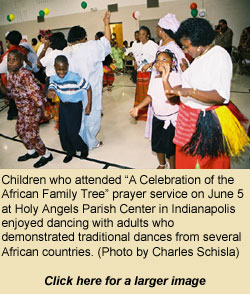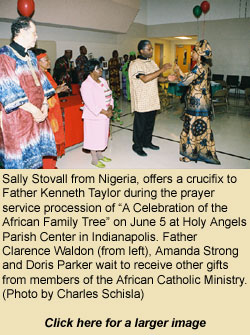Celebration highlights African Catholic community in archdiocese
By Margaret Nelson
 Smiles and clapping erupted from the 170 people who gathered at Holy Angels Parish Center in Indianapolis on June 5 to celebrate the African Catholic Church.
Smiles and clapping erupted from the 170 people who gathered at Holy Angels Parish Center in Indianapolis on June 5 to celebrate the African Catholic Church.
A procession of 17 members of the African Catholic Ministry in the archdiocese began the 4 p.m. prayer service, “A Celebration of the African Family Tree.” Natives of Cameroon, Liberia, Nigeria, Togo, Uganda and the United States carried a crucifix, a Bible, statues of Mary and Jesus, a photo of the Ugandan martyrs and the images of other African saints as the song “Ebintu Byoona Obiheebwa Ruhanga” (meaning “everything is given to you by God and you ought to thank him”) was played.
Immaculate Heart of Mary Reparatrix ( IHMR) Sister Christine Nantaba led the prayers for “our people living in the four corners of the earth” with members of the assembly turning to the east, south, west and north. IHMR Sister Faustina Nansubuga of Uganda poured a libation and Florence Tchuisse of Cameroon held a bowl while Sally Stovall of Nigeria read prayers commemorating the gifts of previous generations and those who still struggle for justice. The assembly answered
A-she meaning “so be it.” The “Praise God Alleluia” was sung in languages used in Nigeria, Uganda and Togo. The worship aid contained translations of all the prayers and songs.
In his homily, Father Kenneth Taylor, director of the archdiocesan Office of Multicultural Ministry and pastor of St. Michael the Archangel Parish in Indianapolis, said that the lost sheep message of Matthew 18 is one that “repeats itself throughout Scripture and Christian history—that God is for all people and that not even one is to be lost.” He called this “an ongoing mission for us.”
“It strikes me that many people around the world and many people throughout history have thought of Africa as a lost continent,” said Father Taylor.
He told of the 2002 statement of the U.S. Bishops in solidarity with Africa, calling the U.S. Church to reach out to contribute and do whatever it can to make sure the love of God becomes a reality in that continent. In their commitment to peace, justice and development, the bishops called on the U.S. government to address present challenges and encourage future growth.
 Father Taylor remembered that the late Pope John Paul II said, “Africa is not destined for death but for life.”
Father Taylor remembered that the late Pope John Paul II said, “Africa is not destined for death but for life.”
Since the time of the Apostles, Father Taylor said, the growing influence of the people of the Catholic Church in Africa has been felt throughout the world. Today, there are 210 million Catholics of African descent in the world, 130 million of them on the continent of Africa itself. In Latin America, there are 60 million Catholics of African descent. There are three million African-American Catholics in the U.S., 250 of them serving as priests. Six hundred native African priests serve here, he said.
Father Taylor explained that work in the archdiocese includes refugee resettlement of people seeking to escape the violence and devastation of their native African countries, such as Sudan and Somalia.
Father Taylor said the archdiocese is trying to “make real Jesus’ message of no one being lost.” And he said that it is important that we have solidarity on an individual level.
“Jesus came to bring salvation to all
people,” Father Taylor said.
Intercessory prayers for the success of the 2006 African National Eucharistic Congress, for all families and for an end to war, disease, hunger and poverty in Africa and around the world were offered in languages spoken in Nigeria, Uganda and Togo.
“I Have Decided to Follow Jesus” was the closing song.
Eleven barefoot members of the archdiocesan African Catholic Ministry presented typical African dances, later inviting the audience to join them.
Father Clarence Waldon, pastor of Holy Angels Parish, led the prayers before the ethnic dinner, which included lamb, fish and chicken served with spinach, rice and yams.
Fifteen members of the ministry
presented a style show, explaining how and where African natives wear the garments shown. The men and women models represented the Indianapolis parishes of Holy Angels, Holy Spirit, St. Andrew, St. Gabriel, St. Michael and SS. Peter and Paul Cathedral.
Sister Christine, chair of the African Catholic Ministry, said that one of the reasons for the ministry is to help native Africans feel welcomed and treasured and to make that population more a part of the Church of Indianapolis.
“We settled here under a variety of circumstances, but all share the common faith,” said Sister Christine.
(Margaret Nelson is a member of St. Andrew the Apostle Parish in Indianapolis.) †

